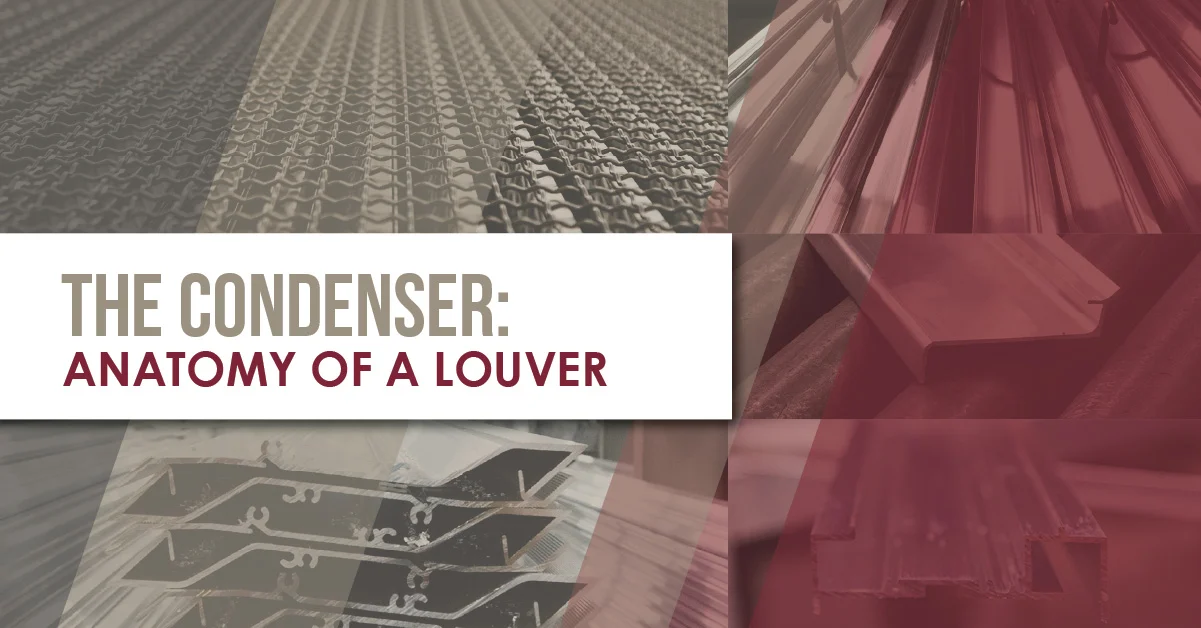In this Condenser article, we take a closer look at the parts that make up a louver. The design seems simple enough, but louvers consist of several parts that all play a role in its function.
The Parts of a Louver
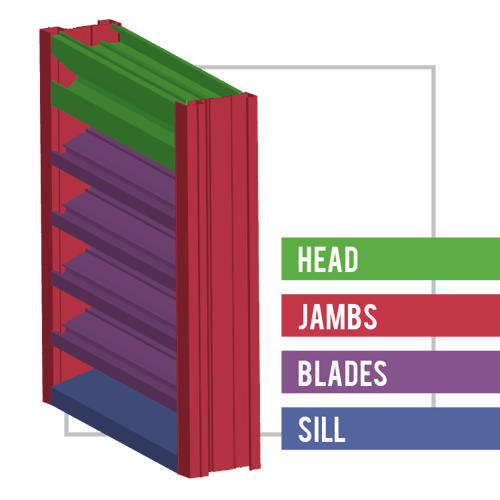
A louver's design is simple: metal slats in a metal frame, installed in an opening. It is important to understand how these parts work as a full assembly. Several factors will determine how a louver performs in an opening, including the louver’s construction. Every part of the louver plays a role. Let’s examine the anatomy of a louver and learn how all its parts come together. We start with the frame. Square and rectangular louver frames will consist of four frame members that make up the four sides of the louver: the head, the sill, and two jambs.
Head
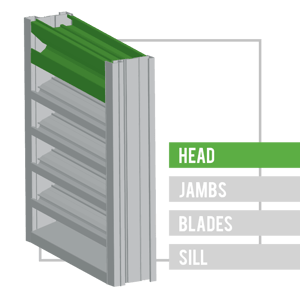
The top side of the louver is called the head, which is oriented to the top of the opening during installation. The head can either be flat or have a curved piece which looks like a hook, which will resemble a louver blade affixed to the head of the louver.
This hook piece does not work like a louver blade. There is no free area between this curve and the main body of the head. The hook acts as a drain channel, capturing any moisture that collects at the top of the louver. During standard operation, air will flow beneath the head and between the blades below.
Function: The louver's head captures rain at the top of the louver. It also helps installers determine the top of the louver, so that it can be properly installed..
Sill
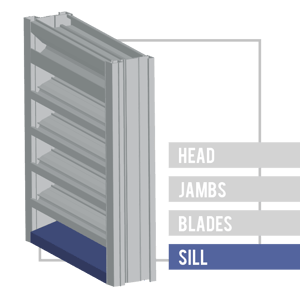
The sill will be on the opposite side of the head. This frame member sits on the bottom of the opening. The sill will sit flat against the bottom of the opening. The sill itself can be flat or sloped, depending on the damper's purpose. Sloped sills ascend from the face to the back of the louver, acting as a ramp for excess water.
This design facilitates drainage by directing water down towards the face of the louver. Sills can receive a drain pan for excess drainage or an extension piece to allow drainage from a recessed opening. Check out our article on drain pans and sill extensions for more details.
Function: The louver's sill is the final destination for drained water. Sill accessories can help with draining rain from the louver.
Jambs

The sides of the frame are called the jambs, which run along the left and right side of the opening. Jambs hold the louver’s blades in place and provide structural support to the louver’s body. Jambs can also serve as drain channels for the excess water collected by drainable blades.
With drain channels, runoff can be directed to the jambs which will drain water down to the sill and out of the louver. For adjustable louvers, the linkage can be installed along the jambs to keep this hardware out of the air stream.
Function: The jambs provide channels from the drain troughts of the blades to the louver's sill. They also provide structural support for the blades.
Mullion
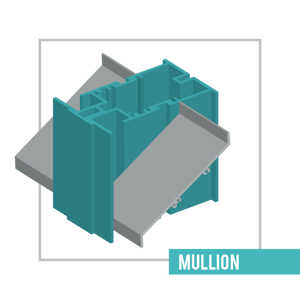
When you place two louvers side by side, their connected jambs create a line known as a vertical mullion. Horizontal mulltions are made when one louver is fastened to the top or bottom of another louver. In this case, the head of one louver is fastened to the sill of another louver.
By default, the mullion will be visible. Visible mullions provide the most support between louver panels. You can choose to have a recessed mullion, where the jamb pieces connected behind the blade profile. There is still a clear division between louvers, but many prefer this over a fully visible mullion. You may also choose an architectural mullion, which hides the mullion from the face of the louver.
Blades at the mullion will be supported with vertical blade braces mounted on the back side of the louver. This option eliminates the line between louvers and creates a continuous look from louver to louver. Certain restrictions may prevent you from choosing this option. For instance, continuous line louvers are not typically rated by AMCA.
Continuous line isn't the only option you have for your louvers. Read Options for Louvers for a full list of available options, including power coat finishes and bird screens.
Function: Mullions are created by fastening two or more louvers together, either at the jambs or at the head and sill. A visible mullion can provide additional support to the larger assembly.
Louver Parts Coming Together
It may seem funny to mention this, but it is important to know which way is up on a louver. Louvers installed upside down may look like any other louver, but they can do more harm than good. For instance, an upside-down drainable louver would provide an easy path for water to enter your ductwork. When installed correctly, a louver’s parts work together to protect openings from unwanted elements.
Did you already know the anatomy of a louver? Is it valuable information in your line of work? Share your stories in the Comments section. We want to know your thoughts!
MCDLG & Continuing Education
MCDLG offers free self-paced courses online through AEC Daily.
Our louver course, Louvers for Style and Aesthetics, goes over the basic stats, terms, and principles involved in choosing louvers for any application. You will also learn how louvers can enhance your project's style.
This course provides continuing education credits for a variety of institutions, including AIA's LIUs. Learn the basics of louvers and earn credit, at your own pace. Visit the MCDLG course page on AECDaily.com today!
Do you have a question on something we haven't covered here? Or maybe you need help from industry experts? MCDLG can help. Contact us by clicking on the button below.
.webp?width=91&height=70&name=MCDLG%20Logo%20(Resize).webp)
